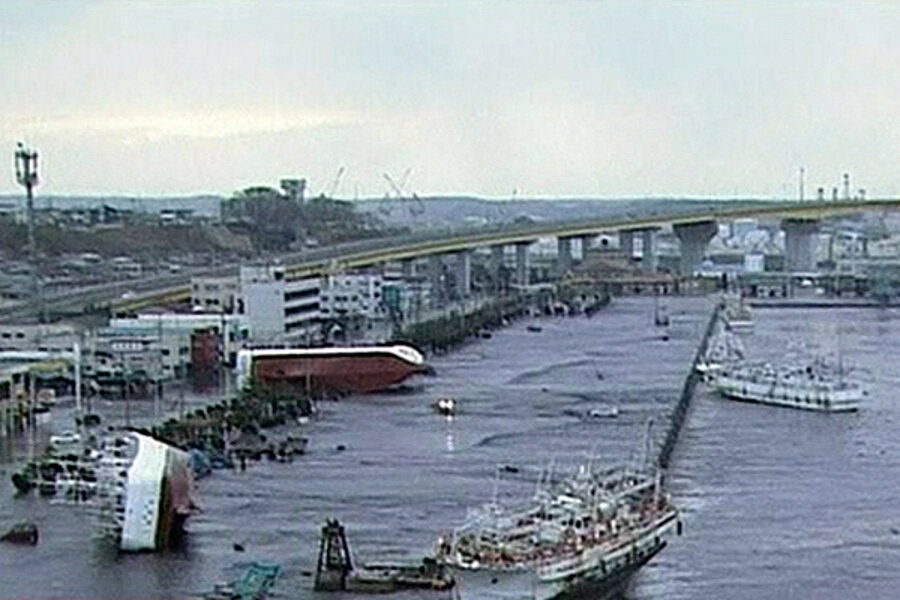Japan earthquake eyewitness: Skyscrapers were 'like trees blowing in the wind'
Loading...
| Osaka, Japan
Three months before Friday's earthquake and tsunami in Japan, Nicholas Roberts moved to Tokyo with his wife. While as aware of anyone living here of the so-called "Ring of Fire" that subjects this nation to repeated earthquake-causing tectonic plate movements, Mr. Roberts recalls how nothing could prepare you to witness cars bouncing into the air and skyscrapers swaying in the wind like giant Redwoods.
The market researcher from London provided the Monitor with this eyewitness account of one of the largest earthquakes in Japanese history:
The surprising thing was that I wasn't the only one who seemed unprepared. I know that native Japanese go through regular drills when they're at school for how you're supposed to cope in this kind of situation, but my Japanese colleagues at the job I started just a week ago seemed as much at a loss about what to do as I was. Perhaps there just is no way you can really prepare for an earthquake.
We were in our second floor office when the first shocks hit. They were relatively gentle, the kind of thing that I've already felt since my arrival and that seem pretty common place for Tokyoites. It didn't take long for it to register that this was not the normal passing tremor though and as the force gradually built, my colleagues’ looks of acknowledgment started to look a bit more like panic.
Then there was what seems like a few seconds of stunned silence. At this point the thought of getting under my desk ran through my mind, this being the one piece of advice I remember from my wife giving me some basic emergency drilling.
As the shaking continued to build something much more primal was telling me to just get out of the building as soon as possible – a thought obviously also running through the minds of my colleagues as we all seemed to dart for the door at once and down the flight of stairs to the car-park behind our building, joining people from surrounding buildings.
It was when we were outside that the most powerful tremors began to hit. Seeing our relatively old building visibly shake from the outside, the external spiral staircase we had all just run down loudly rattling against it's side, I was glad to be outside. It was at this point that panic started to turn to fear, as we looked around at the surrounding skyscrapers visibly swaying, like trees blowing in the wind. It was only talking to people later that I learnt that this bendiness is part of what makes them resistant to quakes. At the time I was genuinely scared that one of these 100-story building could come down on top of us.
It all feels like a bit of a blur now but the main quake seemed to last a few minutes. I remember the cars around us being lighted off the ground. The power cables above our head swinging wildly. People staggering to keep balance. Some guys in another floor of our building who had obviously decided to try and see it out inside darting down the stairs to join us in the car-park, safely, thank God, during a lull. My heart beating, wondering what I should be doing now and what exactly I was doing here anyway.
As soon as it seemed the worst had passed everybody's thoughts turned to their loved ones and we all got our mobiles out at once, but of course the network was overloaded, meaning lots of frantic redialing but very little in the way of contact being made. Somehow the word got round that we should head to our local evacuation centre, a nearby elementary school and we made our way over as streams of people from elsewhere did the same.
Phone networks were still down for calls but I eventually got through to my wife with a Skype message sent from my mobile and as soon as I knew that she was alright I felt the worst was over. Messages coming out over the loudspeaker saying that there was no serious damage reported in Shibuya-ku [a district of Tokyo] also helped to reassure me. Still there were a few false starts moving, as a second wave of less powerful shocks hit and aftershocks continue to roll on, and it was a couple of hours before I set off for Shibuya with a few colleagues to meet my wife and make our way home.
Walking though Harajuku, the most visible effects of the earthquake were the crowds of people jamming the pavements, making their way home without the help of a shut-down public transport system. Otherwise what was really striking was the lack of damage. Apart from a few cracked tiles, there was virtually no evidence that a short time ago we'd just been through what my Japanese colleagues were describing as the worst quake they had ever experienced. I was still feeling shaken at this point but seeing how the city had withstood the shaking did at least reassure me. The fact that the buildings in Tokyo are built with the risk of earthquakes in mind must have saved a lot of lives today.





